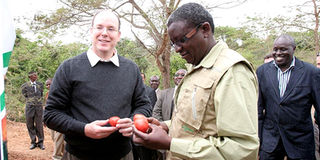10-item checklist strategy to benefit from conserving the environment

PHOTO | CORRESPONDENT
The chairman and founder of Green Africa Foundation, Dr Isaack Kalua, shows Prince Albert II of Monaco tomatoes from one of the Green Villages in Kitui. The Prince was on a tour of the villages to witness how the initiative was changing the lives of ordinary people.
What you need to know:
- The trick is to show how efforts will earn residents more money and put food on their tables
For a long time, environmental conservation had been left to people with a special attachment to the land. Not any more as a Kenya-based organisation – Green Africa Foundation – has for the past 10 years tried to revolutionise environmental conservation using one underlying principle: that unless you show people how conservation will benefit them, how it will earn them more money and put food on their tables, all the effort will be in vain.
Now, the foundation has gone a step further to come up with simple processes that, hopefully, will play a key role in environmental conservation. The concept dubbed Green Villages is a system of organised units of life whose individual residents live by a designated code.
Amidst the insistence on conservation, the question remains how individuals will benefit directly from looking after the environment?
The 2009 census results indicated that at least 5.6 million households use firewood as their primary source of fuel. An average household uses at least 10 kilogrammes of dried wood each day.
On average, this translates to a three-year fast-growing eucalyptus tree per household per day.
In short, Kenya loses about 5.6 million trees daily. These calculations exclude households that use charcoal as their primary source of fuel. The census puts them at 13.3 per cent of the total population.
“We need to show the population how living green can potentially be of benefit to them,” said Dr Isaack Kalua, the chairman and founder of the Green Africa Foundation.
Green Africa has had several successes in this area. As a result, the Green Villages concept was the reason why Dr Kalua recently received the Moran of the Order of the Burning Spear from President Kibaki.
But even with all this perceived success, Green Africa insists it is not reinventing the wheel.
“We are educating the masses on the ways in which looking after their immediate surroundings will reduce conflicts among them. This message is taken to schools, churches and passed on through songs and sports,” he says.
Kenya’s environmental record has been poor, and forest cover has been reduced to less than 5 per cent of the national territory– unsustainable for human and ecosystem survival.
Studies by various organisations reveal that forest cover of 10 per cent is required to sustain life naturally as this affects the availability of rain, underground water, soil fertility and clean air, prevention of soil erosion and overall beauty of landscape.
According to Green Africa, environmental management is a prerequisite for sustainable development.
“If we lose the environment, grand ideas such as the Millennium Development Goals and Vision 2030 will remain just that – ideas,” Dr Kalua said.
The Green Villages were born in the understanding that each region in Kenya has its own set of environmental challenges as well as its own strong points. The villages’ environmental conservation strategies are based on a 10-item checklist. The first is to not only encourage individuals to plant trees but to teach them how to grow them.
The foundation estimates that the survival rate of trees planted in Kenya is slightly under 20 per cent.
Other items on the list are teaching proper animal husbandry skills, horticulture, fish farming and bee-keeping, the argument being that it is only after learning these steps that one can teach about renewable energy sources, waste management systems, eco-tourism and capacity building since the individual will already be at a certain comfort level as most of his or her needs will have been met at the initial production methods.
After all these steps, it is estimated that the Green Villages will have a surplus in production and will require an outlet for their produce. This is where yet another concept kicks in – the Green Africa Virtual Market.
“This will be an online platform on which the foundation will source for produce from the villages and sell it to major outlets and consumers all over the country. Simply put, the centres will be self-sustainable and most importantly show people that they can get something out of conservation,” Dr Kalua said.
The virtual markets will guarantee producers up to 90 per cent of the value of their produce at prevailing market rates.
So far, Green Villages are being piloted in 140 constituencies.
Other projects pioneered by the foundation include the 71 plus one trees that was launched in honour of the late Nobel laureate Wangari Maathai and the latest campaign “Plant Your Age” in which participants are required to plant seedlings equivalent to their ages.
The latter encourages Kenyans to plant a tree in honour of each year that Prof Maathai lived.
For these two campaigns, the foundation has partnered with the Kenya Forests Service, the Rotary Club and other partners.




